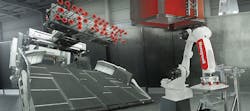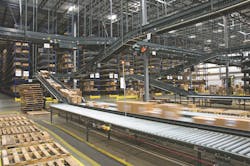Where do Robots Fit in Tomorrow's Supply Chain?
Honeywell recently announced the opening of its new advanced technology center of excellence, Honeywell Robotics. Located in Pittsburgh, the new center is focused on innovating and developing artificial intelligence, machine learning, computer vision and advanced robotics for use across supply chains.
“As AI, machine learning and computer vision become commonplace, Honeywell Robotics will create innovative, breakthrough technologies to help customers alleviate skilled labor shortages, reduce safety risks and eliminate inefficient tasks,” said the center’s director Joseph Lui. “The use of technology – including advanced warehouse execution systems, 3D storage and sortation solutions to improve capacity and efficiency, and autonomous mobile robots – is just the start of the digital transformation in warehouses.”
In ramping up the new center for excellence, Lui’s vision is to provide fully integrated, fully functional, end-to-end robotic systems that are plug-and-play to customer process paths. “Robotics is a rapidly growing industry with low barriers to entry, but high barriers to success. Lots of robotics start-ups are creating tremendous amount of innovation in this space every day,” he says.
Center's immediate goal.
The numbers clearly demonstrate a shift in consumer expectations, putting a heavy stress on traditional supply chain operations. Not only are online sales continuing to surge, the preference for same- or next-day delivery options, means organizations need to change. This is especially true considering that nearly 80 percent of distribution center operations are still performed manually, according to DHL’s Robotics in Logistics Study. With industry growth outpacing the labor pool by a rate of 6 to 1, this growth is creating significant opportunities to automate supply chains.
Improving the adoption rate.
While robotics have become commonplace in production environments, the warehouse environment has yet to experience an explosive adoption rate. “One of the main reasons is that the retailers, e-commerce players and the logistics providers don’t find point robotic solutions particularly useful in solving their labor shortage, throughput or efficiency problems,” says Lui.
Honeywell’s approach will be to grow its robotic solutions portfolio both organically and inorganically by:
- Continuing to develop its home-grown Honeywell Universal Robotic Control (HURC) based robotic solutions;
- Working with best in class robotics start-ups to improve their solutions and integrate them into work cells; and
- Extending the Honeywell Momentum Warehouse Execution System (WES) platform to embrace all HURC-based robotic solutions and other partners’ robotics solutions to enable seamless interworking of the robotic work cells in the warehouse.
Lui told IndustryWeek, “The robotics industry is evolving from point solutions offered today to a more fully integrated, customized, end-to-end robotic solutions that help solve unique problems in customer operations,” he says. The center for excellence positions Honeywell “to take a leadership position in helping drive rapid adoption of robotics in the warehousing environments; and ultimately deliver value to the end-consumers.”
Honeywell also is collaborating with AI researchers at Carnegie Mellon University’s National Robotics Engineering Center to develop breakthrough robotics technologies for distribution centers. The company, through its Honeywell Ventures investment fund, has strategic investments in robotics companies, including Soft Robotics and Attabotics, to help automate complex tasks in dynamic environments to maximize productivity and labor efficiency.
About the Author
Peter Fretty
Technology Editor
As a highly experienced journalist, Peter Fretty regularly covers advances in manufacturing, information technology, and software. He has written thousands of feature articles, cover stories, and white papers for an assortment of trade journals, business publications, and consumer magazines.


